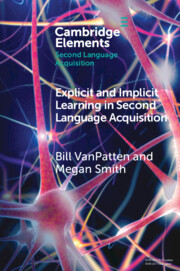Element contents
Explicit and Implicit Learning in Second Language Acquisition
Published online by Cambridge University Press: 25 May 2022
Summary
Keywords
- Type
- Element
- Information
- Online ISBN: 9781009043571Publisher: Cambridge University PressPrint publication: 23 June 2022
References
- 11
- Cited by

